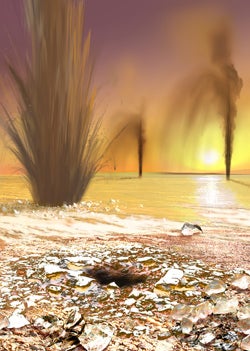Alone or in groups, spider-shape features, fan-like markings, and dark spots appear seasonally on Mars’ south polar ice cap. Scientists from Arizona State University and the U.S. Geological Survey studied one area of Mars’ southern ice cap at 86.3° south, and 99° east and perused more than 200 infrared images taken with the Thermal Emission Imaging System (THEMIS) multi-wavelength camera aboard NASA’s Mars Odyssey orbiter. They link the branching spider channels, which form each spring, to geyser-like jets of carbon-dioxide (CO2) gas.
Each martian spring, as the Sun rises above the ice cap, CO2 jets breach the surface of the Red Planet’s south polar ice cap, spewing a dark mixture of sand and dust hundreds of feet high and wide. The result is dark spots and fan-shape features on the ice cap and clusters of eroded channels radiating beneath it.
The scientists found the markings result from seasonal deposits of CO2 frost. In winter, temperatures on Mars dip to –200° Fahrenheit (–129° Celsius), which causes the frost to recrystalize and become denser. The frost sinks, taking dust and sand particles down with it. By spring, the frost layer transforms into a 3-foot-thick (1m) ice slab that rests atop the layer of sunken particles. Springtime sunlight heats the dark material, and the ice converts directly into a gas — a process called sublimation. Pressure builds beneath the slab until the jets eject CO2, dust, and sand back into Mars’ atmosphere and onto its surface.
The report appears in the August 17 issue of Nature.
Click here to view how martian spiders form.










